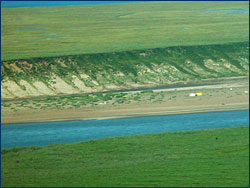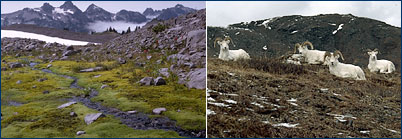Average Rainfall In The Tundra
The tundra biome

Tundra along the Colville River, Alaska.
Tundra is the coldest of all the biomes. Tundra comes from the Finnish word tunturi, meaning treeless plain. It is noted for its frost-molded landscapes, extremely depression temperatures, petty precipitation, poor nutrients, and short growing seasons. Expressionless organic material functions as a food pool. The two major nutrients are nitrogen and phosphorus. Nitrogen is created past biological fixation, and phosphorus is created past precipitation.
Characteristics of tundra include:
- Extremely common cold climate
- Low biotic diversity
- Simple vegetation structure
- Limitation of drainage
- Short season of growth and reproduction
- Energy and nutrients in the grade of expressionless organic material
- Big population oscillations
Tundra is separated into two types:
- Arctic tundra
- Alpine tundra
Arctic tundra

From left: tundra near Churchill, Manitoba, Canada; tundra in the Arctic National Wildlife Refuge, Alaska.
Arctic tundra is located in the northern hemisphere, encircling the n pole and extending south to the coniferous forests of the taiga. The chill is known for its cold, desert-like conditions. The growing flavor ranges from 50 to sixty days. The average winter temperature is -34° C (-30° F), but the boilerplate summer temperature is 3-12° C (37-54° F) which enables this biome to sustain life. Rainfall may vary in unlike regions of the arctic. Yearly atmospheric precipitation, including melting snow, is 15 to 25 cm (6 to 10 inches). Soil is formed slowly. A layer of permanently frozen subsoil chosen permafrost exists, consisting by and large of gravel and effectively fabric. When water saturates the upper surface, bogs and ponds may form, providing wet for plants. There are no deep root systems in the vegetation of the chill tundra, however, there are still a wide variety of plants that are able to resist the cold climate. In that location are almost 1,700 kinds of plants in the arctic and subarctic, and these include:
- low shrubs, sedges, reindeer mosses, liverworts, and grasses
- 400 varieties of flowers
- crustose and foliose lichen
All of the plants are adapted to sweeping winds and disturbances of the soil. Plants are short and grouping together to resist the cold temperatures and are protected by the snowfall during the winter. They tin can bear out photosynthesis at low temperatures and low calorie-free intensities. The growing seasons are short and most plants reproduce by budding and division rather than sexually past flowering. The animal in the arctic is also various:
- Herbivorous mammals: lemmings, voles, caribou, chill hares and squirrels
- Cannibal mammals: arctic foxes, wolves, and polar bears
- Migratory birds: ravens, snowfall buntings, falcons, loons, sandpipers, terns, snow birds, and various species of gulls
- Insects: mosquitoes, flies, moths, grasshoppers, blackflies and arctic bumble bees
- Fish: cod, flatfish, salmon, and trout
Animals are adapted to handle long, cold winters and to brood and raise immature quickly in the summer. Animals such as mammals and birds besides have boosted insulation from fat. Many animals hibernate during the wintertime because food is not abundant. Another alternative is to migrate south in the winter, like birds do. Reptiles and amphibians are few or absent because of the extremely common cold temperatures. Because of constant clearing and emigration, the population continually oscillates.
Tall tundra

From left: alpine tundra in Mt. Rainier National Park, Washington; Dall Sheep in the Arctic National Wildlife Refuge, Alaska.
Tall tundra is located on mountains throughout the world at high distance where copse cannot grow. The growing flavor is approximately 180 days. The dark temperature is normally beneath freezing. Unlike the chill tundra, the soil in the alpine is well drained. The plants are very like to those of the chill ones and include:
- tussock grasses, dwarf trees, small-leafed shrubs, and heaths
Animals living in the alpine tundra are as well well adapted:
- Mammals: pikas, marmots, mountain goats, sheep, elk
- Birds: grouselike birds
- Insects: springtails, beetles, grasshoppers, collywobbles
 Freshwater | |  Marine | |  Desert | |  Forest | |  Grassland | |  Tundra |
Top photograph from the Geosciences in Alaska website; Arctic tundra photos, from left: Dr. Robert Thomas and Margaret Orr © 2004 California Academy of Sciences; U.S. Fish & Wildlife Service, AK. Tall tundra photos, from left: Gladys Lucille Smith © 2000 California University of Sciences; U.S. Fish & Wild animals Service, AK.
--
The original biomes pages were created in fall 1996 by the Biomes Grouping, Biology 1B form, section 115, at UC Berkeley; all were reformatted, with many new photos added, in March, 2007. Coral reef photo past Marguerite Gregory © 2004 California Academy of Sciences. The pages were re-designed in 2019 as function of a full general UCMP website overhaul. Unless noted, content on these pages have non been updated.
Average Rainfall In The Tundra,
Source: https://ucmp.berkeley.edu/exhibits/biomes/tundra.php
Posted by: stantonfackeffaced.blogspot.com


0 Response to "Average Rainfall In The Tundra"
Post a Comment